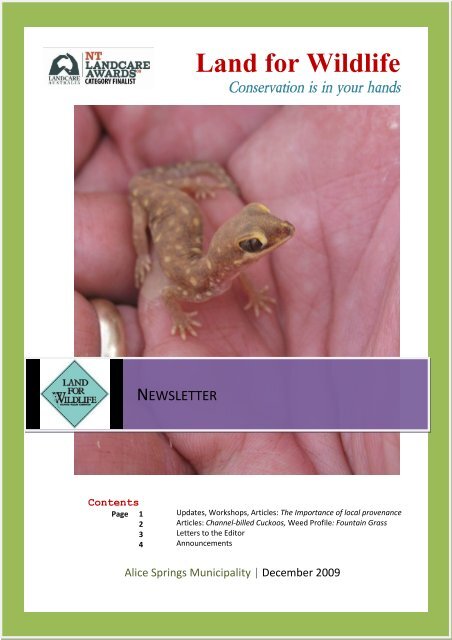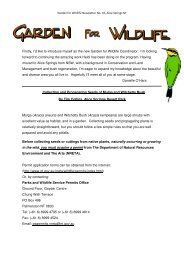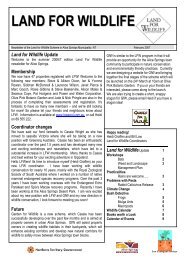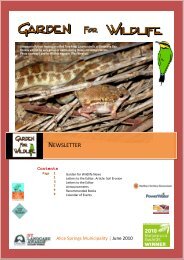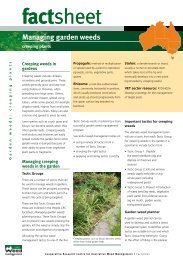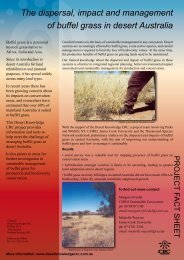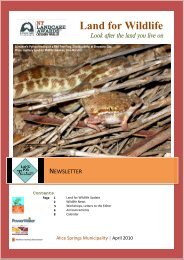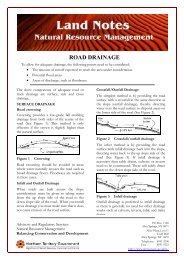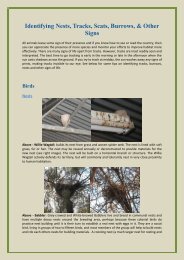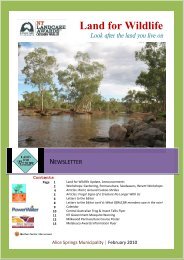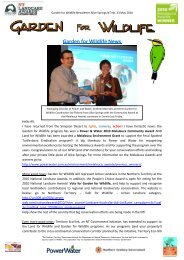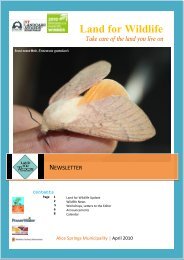Land for Wildlife - Low Ecological Services
Land for Wildlife - Low Ecological Services
Land for Wildlife - Low Ecological Services
You also want an ePaper? Increase the reach of your titles
YUMPU automatically turns print PDFs into web optimized ePapers that Google loves.
Contents<br />
Page 1<br />
2<br />
3<br />
4<br />
NEWSLETTER<br />
<strong>Land</strong> <strong>for</strong> <strong>Wildlife</strong><br />
Conservation is in your hands<br />
Updates, Workshops, Articles: The Importance of local provenance<br />
Articles: Channel-billed Cuckoos, Weed Profile: Fountain Grass<br />
Letters to the Editor<br />
Announcements<br />
Alice Springs Municipality | December 2009
<strong>Land</strong> <strong>for</strong> <strong>Wildlife</strong> Update<br />
<strong>Land</strong> <strong>for</strong> <strong>Wildlife</strong> News, Alice Springs, December 2009<br />
Biodiversity Surveys were conducted during the first weeks<br />
of December in the Racecourse/Winery region of town. The<br />
report of our findings will be released in the new year.<br />
Thanks to all those involved.<br />
Botanist Boyd Wright conducted seedbank surveys in the<br />
Ilparpa Rural region with the help of LfW/GfW members as<br />
part of his study. Surveys of seedbanks across properties in<br />
various stages of Buffel grass control were done to see how<br />
the native seedbank is affected. We look <strong>for</strong>ward to hearing<br />
the results!<br />
Garden <strong>for</strong> <strong>Wildlife</strong>/<strong>Land</strong> <strong>for</strong> <strong>Wildlife</strong> had a very successful<br />
display at the EcoFair this year, and would like to welcome<br />
new members Chris Howden and Kay Bailey who we met<br />
on the day. It was a great event and was wonderful to see<br />
all your smiling faces there! Warm welcomes are also<br />
extended to Rhondda Tomlinson who joined the Garden <strong>for</strong><br />
<strong>Wildlife</strong> program this month.<br />
As a result of downsizing of Parks and <strong>Wildlife</strong> programs,<br />
<strong>Land</strong> <strong>for</strong> <strong>Wildlife</strong> is looking to re-stimulate and coordinate<br />
the feral Spotted Turtle-dove eradication program (more<br />
in<strong>for</strong>mation on this in „Announcements‟). We will coordinate<br />
distribution and circulation of traps, and are available to<br />
help with advice and disposal. The only problem is the<br />
severe shortage of traps!!! (See „Workshops‟ below).<br />
Upcoming Workshop:<br />
Workshops<br />
Making a Spotted Turtle-dove trap<br />
Stay tuned <strong>for</strong> this workshop in the New Year<br />
(date and venue to be confirmed).<br />
Articles<br />
The importance of local<br />
provenance<br />
Have you ever heard the term „local provenance‟ when you<br />
have been buying plants?<br />
A „provenance‟ is a plant population containing a local<br />
genetic variation. Local provenance plants are grown from<br />
seed collected from healthy plants growing near to and in<br />
similar environmental conditions as the planting site, which<br />
gives new plants the best chance of survival.<br />
Many native plant species in Alice Springs also occur<br />
naturally across large areas of Australia, such as the River<br />
Red Gum, Eucalyptus camaldulensis. However, plants<br />
growing in a specific area have adapted to local conditions<br />
over a long period of time. This is to say that the River Red<br />
Gums along the Todd River are different, genetically, from<br />
the Red Gums growing along the Murray River in Victoria.<br />
It is important to conserve these genetic variations as they<br />
ensure a plant is better adapted to its local environment.<br />
For example, local provenance plants are better suited to<br />
local soil conditions, temperatures, rainfall and wind<br />
conditions. They support a wider range of locally native<br />
animals and plants than introduced species, and will have<br />
a better chance of thriving in harsh desert conditions.<br />
Preserving local provenance populations is an important<br />
way of protecting biodiversity. Planting local plants<br />
increases the success of revegetation projects and<br />
decreases the risk of disrupting the local flora gene pool,<br />
not to mention maintaining local character and<br />
conservation value. Bringing in plants from a different<br />
region, even if they are the same plant species, can<br />
through cross-pollination compromise a species‟ genetic<br />
integrity, weakening the population‟s ability to thrive in local<br />
conditions. Plant genes that have been naturally selected<br />
<strong>for</strong> over time (thousands of years of adaptation) will<br />
become diluted, reducing an ecosystem‟s long term ability<br />
to adapt and thrive.<br />
When collecting local provenance seed, similarities in<br />
environmental conditions of the parent plant and planting<br />
site should be assessed through soil type, slope position,<br />
altitude and rainfall. Considering a plant‟s pollination and<br />
seed dispersal methods helps determine the size of a<br />
provenance range, and how far seed can be collected from<br />
the parent plant. For example, where the parent plant drops<br />
seed close by, provenance seed should be collected as<br />
close to the planting site as possible. If seed is dispersed by<br />
wind or water, provenance seed can be collected from<br />
“The Northern Territory Government through the Department of Natural Resources, Environment, the Arts and Sport is pleased to sponsor <strong>Land</strong> <strong>for</strong> <strong>Wildlife</strong>. This publication may<br />
not represent the views of the Northern Territory Government”
<strong>Land</strong> <strong>for</strong> <strong>Wildlife</strong> News, Alice Springs, December 2009<br />
remnant vegetation with matching environmental conditions<br />
that were once connected to the planting site. If plants have<br />
fleshy fruits that are spread by birds, seed could be<br />
collected further afield. Pollination distance <strong>for</strong> many<br />
Eucalypts can be a few kilometres, whereas <strong>for</strong> Acacias the<br />
distance will generally be much smaller.<br />
So be<strong>for</strong>e buying a native plant <strong>for</strong> your garden ask <strong>for</strong> local<br />
provenance at your local nurseries. There are many<br />
nurseries in Alice Springs that specialise in local<br />
provenance, such as Geoff Miers Garden Solutions, the<br />
Greening Australia Nursery (open Thursdays), Tangentyere<br />
Nursery and Australian Plants Society/Olive Pink Botanic<br />
Gardens plant sales, and the commercial nurseries are also<br />
participating in the program.<br />
Channel-billed Cuckoos<br />
This beautiful photograph was taken by Ethno-ornithologist<br />
Bob Gos<strong>for</strong>d in his backyard last week. They have arrived!<br />
The first sightings of Channel-billed Cuckoos, Scythrops<br />
novaehollandiae, were in mid-November, and they can<br />
now be heard all over Eastside, in North side and along the<br />
Todd River at the Telegraph Station. They have travelled<br />
from the tropics of New Guinea and Indonesia and even<br />
tropical Queensland to sneak their eggs into crow‟s nests,<br />
which saves them the ef<strong>for</strong>t of raising their own chicks.<br />
Channel-bills will also head to northern and eastern<br />
Australia to parasitize Kurrawong, Magpie, Buthcherbird<br />
and Crow‟s nests, and once these poor host birds run<br />
themselves thin trying to feed the massive chicks the<br />
Channel-bills will leave us and head north again around<br />
February or March. Have you seen them? Bob Gos<strong>for</strong>d is<br />
recording sightings of Channel-bills this year in an attempt<br />
to know more about their breeding habits in the Centre. So<br />
keep your eyes out <strong>for</strong> juveniles in a crow‟s nest, or adults<br />
chasing crows around, or very irate crows trying to chase<br />
Channel-bills away! If you spot any or if they wake you up<br />
every morning with their banter or let us know where and<br />
when!<br />
Weed Profile: Fountain Grass<br />
Alternative Names: Tender fountain grass, African<br />
fountain grass<br />
Family: Poaceae<br />
Species: Pennisetum setaceum<br />
Form: Grass<br />
Origin: Native to east Africa<br />
Fountain Grass is a densely tufted perennial that grows to<br />
900mm. It lives <strong>for</strong> many years and the long feathery spike<br />
of the flowerhead makes it attractive <strong>for</strong> garden cultivation.<br />
It spreads by seed which is adapted to sticking to fur and<br />
clothing, but can also be transported by wind and water or<br />
carried in dumped garden waste or mud on vehicles.<br />
Pat Hodgens, a Garden <strong>for</strong> <strong>Wildlife</strong> member, has spent<br />
many warm days removing the grass from his front yard,<br />
and has persuaded a neighbour to do the same. “When we<br />
bought our house in Old Eastside it was advertised with a<br />
„beautiful native garden‟, but in fact there was only exotic<br />
Fountain Grass growing everywhere. I removed all of it<br />
using a crowbar, as it has a really thick root mass, and<br />
have removed as much of the top seed as possible. Since<br />
then we have planted native grasses, and the Fountain<br />
Grass has not returned. However we haven‟t had any rain<br />
since then, so we shall see what happens after a<br />
downpour.” Pat would like people to be more aware of the<br />
grass, that it is not an ornamental plant, but in fact a weed.<br />
“The Northern Territory Government through the Department of Natural Resources, Environment, the Arts and Sport is pleased to sponsor <strong>Land</strong> <strong>for</strong> <strong>Wildlife</strong>. This publication may<br />
not represent the views of the Northern Territory Government”
“I have seen people planting Fountain Grass on their<br />
footpath.” Several<br />
other <strong>Land</strong> and<br />
Garden <strong>for</strong> <strong>Wildlife</strong><br />
members have had<br />
the same experience<br />
of Fountain grass<br />
taking over their<br />
blocks. It is as good<br />
or better than Buffel<br />
Grass at overdoing its<br />
welcome.<br />
<strong>Land</strong> <strong>for</strong> <strong>Wildlife</strong> News, Alice Springs, December 2009<br />
For more in<strong>for</strong>mation on weeds around town and beyond,<br />
check out the new book launched by Greening Australia:<br />
„Weeds of Central Australia: a field guide‟ by Sunil Dhanji –<br />
a fantastic resource available from Red Kangaroo Books<br />
and Greening Australia.<br />
Photo Credit: C. Martus, www.cal-ipc.org<br />
Letters to the Editor<br />
In response to the Desert Park enquiry about the<br />
occurrence of feral Spotted Turtle-dove trapping, and the<br />
lack of turtle-dove drop-offs at their disposal enclosure:<br />
Wow Ilse,<br />
No feral birds.!! Most interesting.<br />
We use the trap that was made in the July workshops.<br />
There were a range of suggestions discussed at the<br />
workshops <strong>for</strong> the use/disposal of the catch, amongst<br />
which was the drop point at the Desert Park.<br />
At our place, after humanely dispatching them, we bury<br />
them as fertiliser capsules or include them in our chicken‟s<br />
diet. We value the trap and greatly appreciate the work of<br />
<strong>Land</strong>For<strong>Wildlife</strong>&Garden <strong>for</strong> <strong>Wildlife</strong>.<br />
Garden <strong>for</strong> <strong>Wildlife</strong> member<br />
Hi Ilse,<br />
It really is too far to drive out (to the Desert Park drop-off<br />
point) <strong>for</strong> some of us assuming we have cars and are not<br />
on shift work that makes it hard to get out there. We have<br />
been killing our captives ourselves as it's easier and<br />
perhaps others have been doing that too.<br />
Sara Cox<br />
Garden <strong>for</strong> <strong>Wildlife</strong> member.<br />
Ed - Whilst the Desert Park does use turtle-doves that are<br />
delivered to the feral turtle-dove drop-off enclosure, their<br />
greater concern is that trapping is not taking place in the<br />
community, and that feral turtle-dove numbers may be on<br />
the increase. However if trapping is taking place and some<br />
people prefer to dispose of the turtle-doves themselves <strong>for</strong><br />
reasons such as mulching or convenience, and the birds<br />
are euthanized humanely then that is fine!<br />
Hey Ilse,<br />
I would love to get a trap- we have dozens at our place and<br />
apart from knocking their nests out I haven't been able to<br />
do anything- ta<br />
Garden <strong>for</strong> <strong>Wildlife</strong> member<br />
Hi Ilse,<br />
I‟ve had some strange requests in my time but this one is<br />
one of the best!<br />
(In reference to the suggestion to ‘get trapping’ <strong>for</strong> Turtle-doves<br />
<strong>for</strong> the Desert Park!)<br />
Trevor Shiells<br />
<strong>Land</strong> <strong>for</strong> <strong>Wildlife</strong> Member<br />
Hi Ilse,<br />
Good work trying to get the trapping up and running again.<br />
Are there any spare traps? The turtle doves near our place<br />
have been busy breeding lately and I'd love to get rid of<br />
them.<br />
Thanks!<br />
Garden <strong>for</strong> <strong>Wildlife</strong> member<br />
Photos from the Tanami<br />
The photographs below were sent to us from the Tanami<br />
Desert and feature a Black-headed Monitor, Varanus<br />
tristis. V. tristis can be found in timber country, around hill<br />
country, and around houses around town that have walls<br />
that can be climbed. Olive Pink Botanic Garden had heaps<br />
of them a few years ago, and I recently saw one hanging<br />
from the wall of the office! The Black-headed Monitor is<br />
long and slender with a black tail and neck – but not nose!<br />
It is a good climber and likes to eat the geckos around the<br />
house. This fella is very old but it appears he gets a lot to<br />
eat! He has a chunk off the end of his tail, as the last part<br />
of the tail is smaller than the main part of the tail indicating<br />
possible regrowth, which may be due to a run-in with a<br />
Dingo.<br />
“The Northern Territory Government through the Department of Natural Resources, Environment, the Arts and Sport is pleased to sponsor <strong>Land</strong> <strong>for</strong> <strong>Wildlife</strong>. This publication may<br />
not represent the views of the Northern Territory Government”
<strong>Land</strong> <strong>for</strong> <strong>Wildlife</strong> News, Alice Springs, December 2009<br />
discussion with town councillors or NT legislators to let<br />
them know the benefits of our program, so that we may<br />
better our chances to secure funding in the future to<br />
support the program.<br />
Announcements<br />
So what is the latest on feral Spotted Turtledoves?!!<br />
Spotted Turtle-Dove control is currently entirely in the<br />
hands of the community. There has been a recent enquiry<br />
as to whether Spotted Turtle-Dove trapping is still taking<br />
place within the community, and an email I sent out to all<br />
members reassured us that there are many of you putting<br />
in the ef<strong>for</strong>t to help eradicate this feral species from town<br />
(some evidence is shown in the „Letters to the Editor!).<br />
There was also an overwhelming request <strong>for</strong> traps which is<br />
fantastic! It‟s great to see the enthusiasm <strong>for</strong> this project<br />
especially because we as the public are the only active<br />
workers on the ground trapping. Un<strong>for</strong>tunately there is a<br />
shortage of traps, apologies to those in waiting. <strong>Land</strong> <strong>for</strong><br />
<strong>Wildlife</strong> will be running a trap making workshop in the new<br />
year so stay tuned, but until then can anyone who has a<br />
Parks & <strong>Wildlife</strong> or a home-made trap that is not<br />
currently using it and wouldn’t mind lending it to other<br />
GfW/LfW members please let me know on 8955 5222 or<br />
lfw@lowecol.com.au. Thanks!<br />
Funding<br />
We need your help to boost our visibility!<br />
<strong>Land</strong> <strong>for</strong> <strong>Wildlife</strong>/Garden <strong>for</strong> <strong>Wildlife</strong> has recently been<br />
unsuccessful in obtaining funding through the Town<br />
Council. We would like to raise the profile of the program,<br />
to let the Council and wider community know that the<br />
landholders of Alice Springs are concerned about and<br />
active in conservation on their lands, and that the program<br />
plays a key role in providing landholders with support and<br />
advice. If you feel that you are gaining from the LFW and<br />
GFW programs please take any opportunity when in<br />
Merry Christmas!<br />
Enjoy the Christmas period, whether you‟re staying in<br />
Alice, or escaping the heat <strong>for</strong> awhile. Remember to make<br />
sure any irrigation you have is functioning properly, the<br />
timer is working, and the pipes aren‟t leaking, so your<br />
plants survive the summer! Ensure your garden mulch is<br />
topped up to retain moisture and repress weeds.<br />
Have a wonderful break, and see you all next year!<br />
Take care,<br />
Ilse & Bill<br />
<strong>Land</strong> <strong>for</strong> <strong>Wildlife</strong> Coordinators<br />
This newsletter has been produced by<br />
Ilse Pickerd and Bill <strong>Low</strong>, LfW coordinators, W.A. <strong>Low</strong><br />
<strong>Ecological</strong> <strong>Services</strong>,<br />
Contact Ilse on 89555222 or lfw@lowecol.com.au<br />
“The Northern Territory Government through the Department of Natural Resources, Environment, the Arts and Sport is pleased to sponsor <strong>Land</strong> <strong>for</strong> <strong>Wildlife</strong>. This publication may<br />
not represent the views of the Northern Territory Government”


